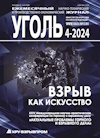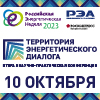
COAL-MINING FIELD
Original Paper
UDC 62-83:622.411.332 © V.A. Bobin, A.А. Grabskij,E.P. Grabskaya, 2022
ISSN 0041-5790 (Print) • ISSN 2412-8333 (Online) • Ugo’ – Russian Coal Journal, 2022, № 4, pp. 39-45
DOI: http://dx.doi.org/10.18796/0041-5790-2022-4-39-45
Title
ON THE INFLUENCE OF HYDROGEN DEGASSING ON THE FORMATION OF GAS, GAS HYDRATE AND COAL DEPOSITS OF METHANE
Author
Bobin V.A.1, Grabskij A.А.2 ,Grabskaya E.P.3
1Research Institute of Comprehensive Exploitation of Mineral Resources named after Academician N.V. Melnikov RAS, Moscow, 111020, Russian Federation
2Sergo Ordzhonikidze Russian State University for Geological Prospecting, Moscow, 117997, Russian Federation
3 National University of Science and Technology ”MISIS” (NUST ”MISIS”), Moscow, 119049, Russian Federation
Authors Information
Bobin V.A., Doctor of Engineering Sciences, Head of the Departament , bobin_va@mail.ru
Grabskij A.А., Doctor of Engineering Sciences, Professor, Head of the Departament of Mining engineering, e-%20%20%0dgrabskyaa@mgri.ru">mail:
%20%20%0dgrabskyaa@mgri.ru">grabskyaa@mgri.ru
Grabskaya E.P., PhD (Economic), Associate professor of the department ”Industrial Strategy”, e-mail: pgmk@mail.ru
Abstract
The paper shows that hydrogen-methane degassing of the Earth is a source of gas, gas hydrate and coal deposits of methane, which, in an untouched state of development and production, are the only protection of the Earth's atmosphere from greenhouse gases. At the same time, methane from gas fields enters their space from external sources lying in the depths of the earth's mantle. In coal seams, most of the methane is sorbed by block sorption particles, and most of the hydrogen, interacting with the substance of coal, reduces its shear strength. In turn, hydrogen degassing leads to the formation of gas hydrate deposits, which, having a very low permeability, protect the Earth's atmosphere from greenhouse gas emissions. To solve the same problem, an effective technology of simultaneous coal and methane extraction using gyroscopic mining combines is proposed.
Keywords
Global hydrogen degassing, Earth's atmosphere, Gas, Gas hydrate and coal deposits, Methane.
References
1. Larin V.N. Our Planet Earth: origin, composition, structure, and development of the originally hydridic Earth. Moscow, Agar Publ., 2005, 248 p. (in Russ.).
2. Trubetskoy K.N. & Galchenko Yu.P. Geoecology of the Earth's subsoil development and environmental geotechnologies in mining. Moscow, Nauchtekhlitizdat Publ., 2015, 360 p. (In Russ.).
3. Galchenko Yu. &Ozaryan Ju. Method of quantitative assessment of the regularities of natural restoration of biota in zones of technogenic disturbance. E3S Web of conferences Khabarovsk, 2018, (56), pp. 2-7.
4. Zakirov S., Zakirov E., Indrupsky I., Anikeyev D., Lukmanov A. & Klimov D. Oil and gas recovery methods: a growing source of environmental disasters. REGNUM Publ., 2019, March 10. (In Russ.).
5. Zorkin L.M. Genesis of gases in the subsurface hydrosphere as related to the development of hydrocarbon prospecting methods. Geoinformatika Publ., 1984, pp. 34-45. (In Russ.). Available at: https://regnum.ru/news/2587855.html (accessed: 15.03.2022).
6. Zimakov B.M. & Podmarkov A.V. Methodology of using punch cards in determining the gas content of coal seams. Moscow, 1972, 30 p. (in Russ.).
7. Bobin V.A. Sorption processes in natural coal and its structure. Academy of Sciences of the USSR, Research Institute of Comprehensive Exploitation of Mineral Resources, Moscow, 1987, 104 p. (In Russ.).
8. Bulat A.F., Skipochka S.I. & Palamarchuk T.A. A physical and chemical model of methane generation in a coal seam. Proceedings of the National Academy of Sciences of Ukraine, 2009, (11), pp. 53-58. (In Russ.).
9. Gamburtsev G.A. Selected Works. Moscow, Academy of Sciences of the USSR Publ., 1960, 462 p. (In Russ.).
10. Riznichenko Yu.V. & Kosminskaya I.P. On the nature of the Earth's crust and upper mantle stratification. Doklady Akademii nauk SSSR, 1963, Vol. 153, (2), pp. 323-325. (In Russ.).
11. Sadovsky M.A., Bolkhovitinov L.G. & Pisarenko V.F. Deformation of geophysical environment and seismic processes. Moscow, Nauka Publ., 1987, 100 p. (In Russ.).
12. Nikolaevsky V.N. Earth's crust, dilatancy and earthquakes. Moscow, Mir Publ., 1982, pp. 133-215. (In Russ.).
13. Kozlovsky E.A., Sharov G.N., Kontorovich A.E. et al. Gas explosion hazards in underground coal mining in Kuzbass. Fundamental?nye i prikladnye voprosy gornyh nauk, 2018, Vol .5, (1), pp. 76-82. (In Russ.).
14. Polevshchikov G.Ya., Kozyreva E.N. & Bobin V.A. On thermal processes in establishing sorption equilibrium in sealed flasks with gas-bearing coal. Koks i himiya, 2020, (4), pp. 2-9. (In Russ.).
15. Gevorkyan V.Kh. & Sokur O.N. Gas hydrates as a product of mantle degassing. Geologiya i poleznye iskopaemye mirovogo okeana, 2012, (1), pp. 52-65. (In Russ.).
16. Popkov V.I., Solovyov V.A. & Solovyova L.P. Gas hydrates as a product of the deep-earth degassing. Geologiya, geografiya i global?naya energiya, 2012, (3), pp. 56-67. (In Russ.).
17. Tianle Liu. Justification and development of flushing and plugging compositions for well drilling in conditions of ice and hydrate formation (as exemplified by gas hydrate exploration in Qinghai province, China). Abstract of Ph.D. thesis. National Mineral Mining University. St. Petersburg, 2013, 20 p. (In Russ.).
18. Gas hydrates: extraction methods and development prospects. Fact sheet. Directorate for Strategic Research in Power Engineering. Moscow, 2013, 22 p. (In Russ.).
For citation
Bobin V.A., Grabskij A.А.& GrabskayaE.P. On the influence of hydrogen degassing on the formation of gas, gas hydrate and coal deposits of methane.Ugol’, 2022, (4), pp. 39-45. (In Russ.). DOI: 10.18796/0041-5790-2022-4-39-45.
Paper info
Received February 8, 2022
Reviewed February 16, 2022
Accepted March 22, 2022









